Kuhli Loaches are small, peaceful fish that make a great addition to a laid back heavily planted community tank.
Provided with the right care, they’ll quickly become a tank favorite, displaying oddball behaviors while helping to keep your tank clean.
In this guide, I’ll help you understand what you need and if kuhli loaches are right for you.
Care Overview
Kuhli Loach (Pangio kuhlii)
Key Characteristics
- Size: 4 inches (10cm)
- Life span: 10 years
- Temperament: Friendly shoaling fish
- Tank Mates: Other peaceful community fish
- Living Zone: Bottom
- Diet: Omnivore
Water Parameters
- Temperature: 75°-85°F (24°-29°C)
- Ammonia/Nitrite: 0
- Nitrate: >30 ppm
- pH: 5.5-7.0
- GH: 3-5 dGH (50-83 ppm)
- KH: 3-4 dKH (53-71 ppm)
Care Schedule
- Daily: feeding just before aquarium lights turn off
- Weekly: Water test. If nitrates are high, do 20-25% water change
- Monthly: Plant trimming, equipment check
Scientific Classification
- Kingdom: Animalia
- Phylum: Chordata
- Class: Actinopterygii (ray-finned fishes)
- Order: Cypriniformes
- Family: Cobitidae (loaches)
- Genus: Pangio
- Species: Pangio kuhlii
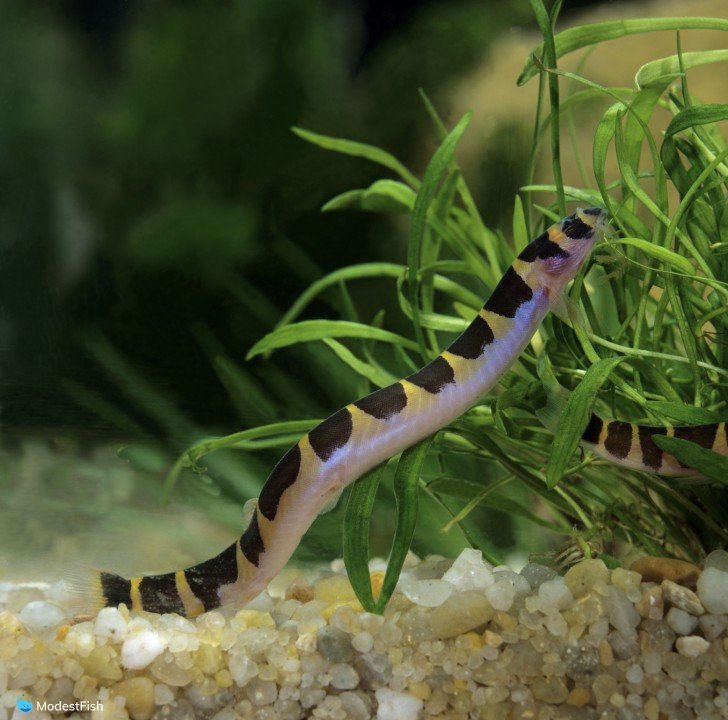
Tank Setup Overview
Tank Supplies
20 gallon tank (or more)
Soft sand substrate
Filter with intake covered by a sponge pre-filter
Heater
LED lighting
Thermometer
Live Plants
Decorations
Water Conditioner
5 gallon bucket
API Master Test Kit
Algae scraper
Gravel vacuum
Diet
Fluval Bug Bites Bottom Feeder Formula
Frozen Bloodworms
Omega One Shrimp Pellets
Blanched veggies
Table of Contents
Kuhli Loach Species Introduction
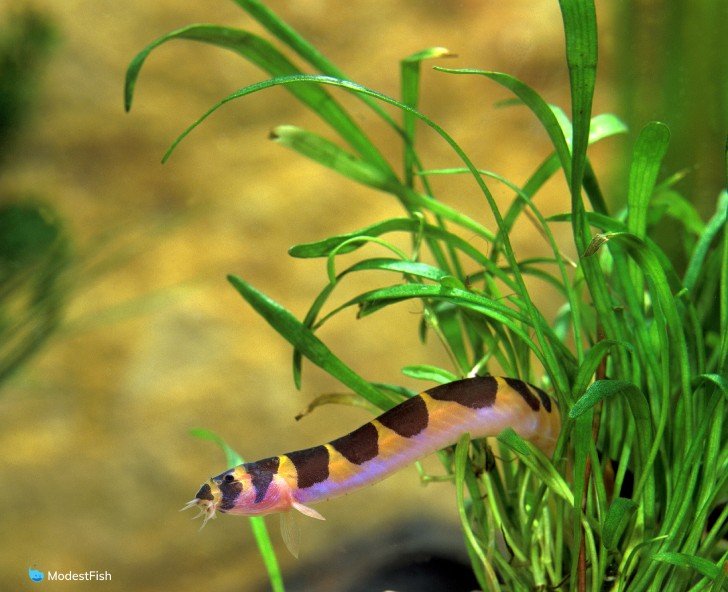
Kuhli loaches are scavengers by nature, scouring the bottoms of their waterways, looking for pretty much anything small enough to fit in their mouths: fish eggs, insect larvae, tiny crustaceans, etc.
Native to Indonesia and Malaysia, these fish come from rivers and streams with soft, slightly acidic waters. Since most of the kuhli loaches available in the aquarium trade are wild caught, it’s best to mimic their natural water parameters as much as possible.
These loaches are a shoaling fish. So they hang around together in groups for social reasons, but they don’t swim together in a coordinated fashion like a schooling species. They’re often found in groups of a dozen or more.
Because of this shoaling behavior, you should plan on keeping a group of at least five or more.
Anatomy
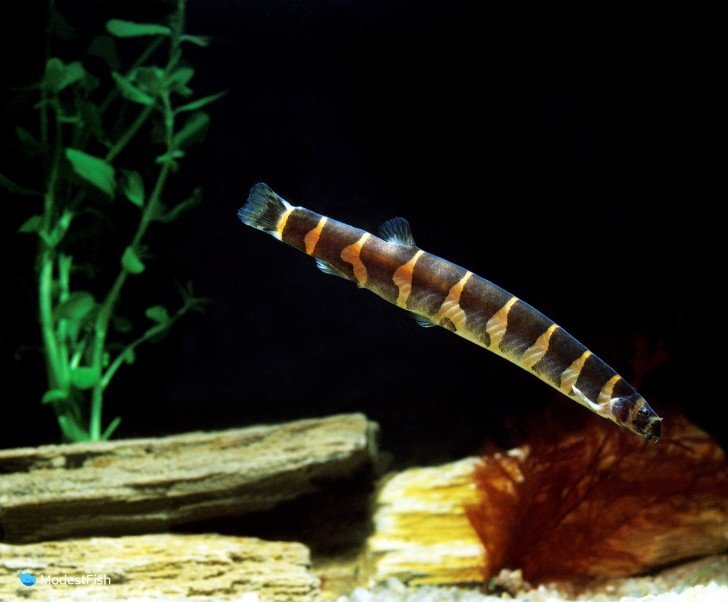
Kuhli loaches might look a lot like an eel, but they’re classified as a fish, mainly because of their fins.
True eels don’t have any pelvic fins and their dorsal, anal and caudal fins are fused together, forming a kind of paddle on their back end. A kuhli loach does have pelvic fins and its dorsal, caudal and anal fins are distinct and separate from each other.
Scaleless Fish
Kuhlis are a so-called “scaleless fish.” They aren’t completely scaleless, but their scales are really small and spread very far apart, leaving their skin exposed.
This makes them more vulnerable because they don’t have a protective layer of tough scales covering their much softer skin.
Pro Tip: Scaleless fish are much more sensitive to salt and medication levels in tank water. What would be a normal dose of medication for most fish can be deadly to a kuhli loach. Consult a veterinarian that specializes in fish before adding medications to a tank that houses this species.
Aquarium Care & Tank Equipment
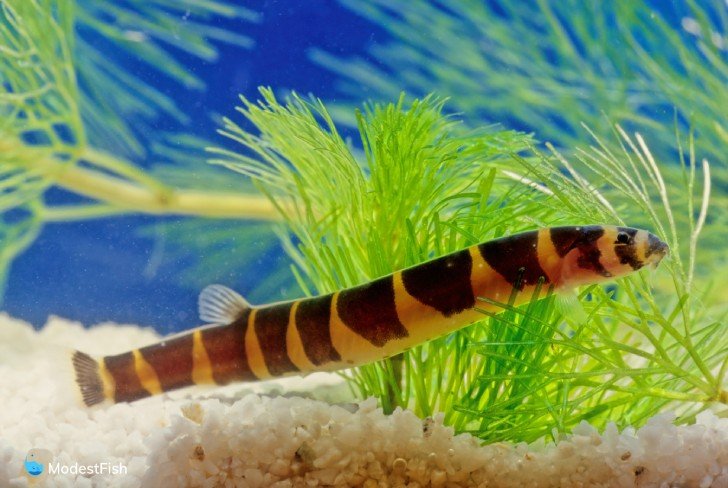
Here’s a quick overview of the equipment you’ll need before we get into each piece:
- 20 gallon tank
- Soft sand substrate
- Filter with intake covered by a sponge pre-filter
- LED lighting
- Heater
- Thermometer
- Live plants
- Decorations
Aquarium Size
I recommend at least 20 gallons for a shoal of 4-6 kuhli loaches. It’s likely you’ll end up keeping them in a community tank, so having a larger tank will make this easier to manage.
Heater
This species originates from tropical waters and needs temperatures of 75°-85°F (24°-29°C) in order to thrive. So you absolutely need to add a heater to your tank in order to maintain a healthy temperature range for them.
I always recommend the Fluval E series heater. I’ve tested and used so many heaters, and this heater wins all of the safety and reliability tests.
Filter Intake
Kuhli loaches like to explore any little dark place they can find. Unfortunately, that sometimes means the filter intake.
Some aquarists have gone searching for missing kuhli loaches and found them munching on detritus in the filter. This can injure or even kill the loach, so you should do everything possible to prevent this from happening.
It’s best to cover your intake with a sponge pre-filter to prevent kuhlis, and other little critters, from getting sucked in.
Pre-filter sounds complicated and sophisticated but all it really means is an extra strainer with a sleeve of coarse sponge that goes over it.
Substrate
The best kind of substrate for these fish is soft sand. Kuhli loaches love to dig around in the substrate, and will even bury themselves below the surface.
These little guys are also a filter feeder. In the wild, they scoop up mouthfuls of sand and sift through it so they can eat things like insect larvae, tiny crustaceans or even fish eggs.
So they’ll really appreciate a sand substrate in their tank since this is a big part of their natural behavior.
Plants and Decor
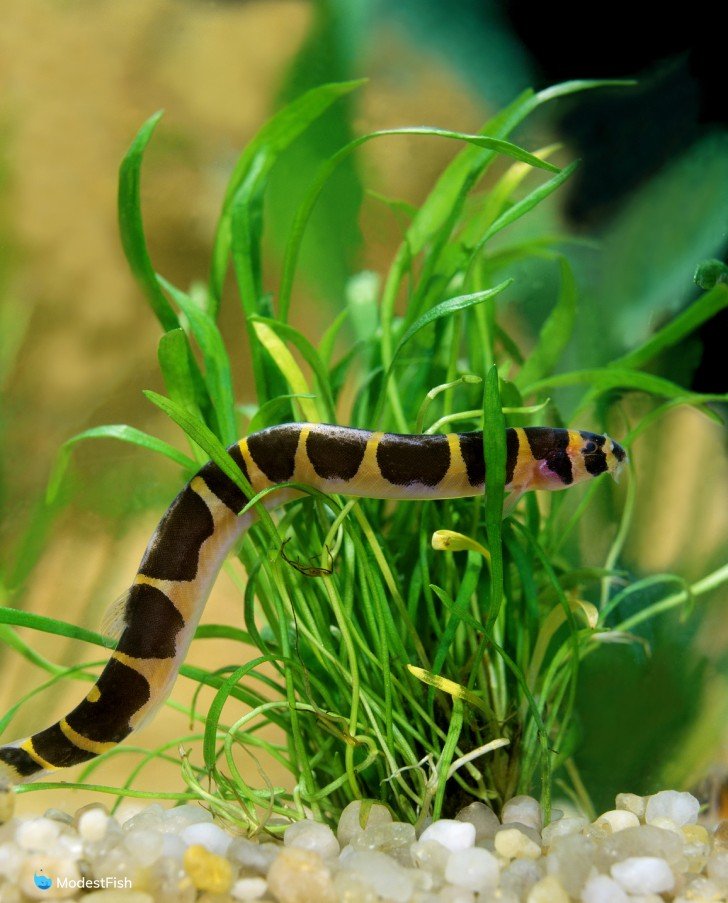
Having the right kind of plants and decor is essential if you’re going to keep kuhli loaches.
Kuhli loaches are shy little critters. I mean, who can blame them? They can’t really defend themselves and bigger fish will just suck them up like spaghetti noodles. Hiding is their only means of defense.. They also like to hide together and get in a big pile with each other.
These fish need some dark little hiding spaces like small caves, the underside of driftwood or plant roots (especially plants like Java fern or anubias) or inside decor.
They want a somewhat tight space to hide in so they feel more secure.
Lighting
They are nocturnal and will not venture out into the bright light. Unfortunately, this makes it really hard to see them because they’re hiding all the time (although in bigger groups you will see more activity.
If your lights are dimmable, mimicking sunrise and sunset might encourage them to come out and forage. Also, adding a blue or red night light to your tank will let you see them when the bright lights are off.
Water Parameters
In order to provide kuhli loaches with safe water parameters, you must introduce them to a cycled aquarium. If you haven’t cycled an aquarium, you can see our guide on the nitrogen cycle here.
- Temperature: 75°-85°F (24°-29°C)
- Ammonia/Nitrite: 0
- Nitrate: >30 ppm
- pH: 5.5-7.0
- GH: 3-5 dGH (50-83 ppm)
- KH: 3-4 dKH (53-71 ppm)
Kuhli loaches originate from waterways in Indonesia and Malaysia. Their native streams have a slightly acidic pH and very little hardness.
Unlike a lot of fish in the aquarium trade, these fish are mostly wild caught, not tank bred. So it really is best to give them water conditions that mimic their native waters as much as possible.
Feeding

Kuhli loaches are scavenging bottom feeders, which means that they’re not picky eaters and will gladly scarf down just about any kind of food. They’ll gladly vacuum up any leftovers from other mess eaters in your tank.
But just because kuhli loaches make a great cleanup crew doesn’t mean you can skip feeding them as well.
The best way to do this is to add sinking food right when you turn the lights off for the night. Give them a varied diet made up of high quality foods.
Fluval Bug Bites Bottom Feeder Formula provides a really similar diet to what they would get in nature since its main ingredient is insect larvae.
Omega One Shrimp Pellets are another great choice that are made from quality ingredients like whole shrimp and fish.
Tank Mates
This is a shoaling species, so plan on keeping them in a group of at least five to keep them happy.
Kuhli loaches are small, super peaceful and delicate when it comes to roughhousing with other fish. So they need to be protected and only housed with other peaceful community fish. Some good tank mates include:
- Neon tetra
- Cardinal tetra
- Blackskirt tetra
- Harlequin rasboras
- Chili rasboras
- Cherry barb
- Celestial pearl danio
- Zebra danio
- Fancy guppy
- Platy fish
- Hatchetfish
- Otocinclus catfish
- Cory catfish (but they’ll compete for food)
- Bristlenose pleco
- Clown pleco
- Nerite snail
- Mystery snail
You could pick a few tank mates from this list, have a vibrant community tank and the kuhli loaches would help keep the tank nice and neat by eating the scraps everyone else misses.
If you mix in other bottom feeding fish, like corydoras catfish, it’s important to make sure everyone gets enough to eat. When you add food at lights out, put it in several places around the tank to make sure everyone gets an equal shot at grabbing some dinner.
Tank Mates to Avoid
Since kuhlis are so little, and their only defense is to hide, you should avoid any kind of large, aggressive fish.
I would recommend staying away from cichlids (except maybe rams). They just get too large and could easily bully or kill kuhlis.
Even cichlids like angelfish that are often kept with other community fish would be too much. Monster fish like pacus, shovelnose catfish, redtail catfish or gar would be out of the question.
Goldfish are pretty much eating machines with fins and they would definitely suck up a kuhli loach like a lo mein noodle.
Maintenance Schedule
Equipment needed:
- Algae scraper
- API Master Test Kit
- Water Conditioner (to make tap water safe)
- Gravel vacuum
- 5 gallon bucket
Maintaining a tank with kuhli loaches is simple. You’re going to need to feed daily (just before you turn the lights off), and just have a quick check all your equipment is performing well.
Weekly, test for ammonia, nitrites, and nitrates. You can perform water changes if your nitrates start to climb into unsafe numbers. If your ammonia or nitrites start to climb, initially you can help detoxify the water by adding seachem prime and doing a water change. But, you’ll need to identify what caused this spike and eradicate the issue.
Every month or so, evaluate whether or not you want to trim back some plants. And have a good check all of your equipment is working properly.
Breeding Kuhli Loaches
Breeding kuhli loaches can be difficult, but there are reports of successful spawning in an aquarium environment.
Your best bet is to move about eight loaches into a 20 gallon (75 liter) tank with no other fish.
The tank should have a sand substrate and be filtered using a basic sponge filter. Make sure to provide lots of plants and hiding places so that the adults are as comfortable as possible.
It’s important to add floating plants with roots that hang down, like dwarf water lettuce, as well as plants that are easy to remove, like Java moss. Loach eggs will get stuck to these after spawning so you can more easily move them to another tank.
Raise the temperature to about 83°F (28°C).
Start to get the adults into spawning condition by feeding them protein rich foods like bloodworms, brine shrimp, mysis shrimp and tubifex worms.
It’s best to do 5% water changes daily. Once it looks like females have begun to get plump with eggs, start to add 1 gallon of cool distilled water when you turn off the lights in the evening. This simulates the evening showers typical of the rainy season.
If all goes well, pairs of fish will start to swim together the next morning. They will dash up to the surface together, wrap around each other and drop back down to the substrate.
As they drop, the female will release eggs and the male will fertilize them. The eggs will sink down and get stuck on the plant roots and moss in the tank.
Remove the plants, and the eggs stuck to them, and place them in another tank so that the fry can be raised in safety.
Are Kuhli Loaches Right for You?
There are some things to consider before you add this species to your tank.
Since they are primarily wild caught fish, it’s best to keep them in water conditions that are close to their native habitat, that means soft, slightly acidic water.
If your water parameters aren’t a good match, this might not be the fish for you.
They are also small, peaceful fish that are vulnerable to attack. They make a great addition to a laid back community tank, but if you have big, mean fish like cichlids, they are not a good fit.
Also, they need a wide variety of hiding spots and so they do best in a heavily planted/decorated tank. If you’re running a wide open, bare bottom setup, these little loaches would not thrive in that environment.
But, if you can provide what they need, kuhli loaches are a great species to keep. They are a nifty little critter that does a great job helping to keep the tank clean, and they don’t add very much bioload.
They’re unique and useful, who doesn’t love that?

Thank you for taking the time and explaining things in leiman’s terms and for generously sharing your knowledge! Myself and my new Kuhli loaches thank you!